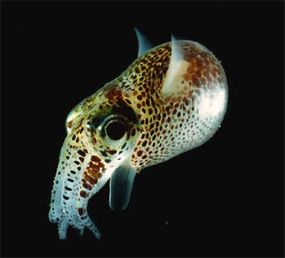Quck answer
Bioluminescence is the ability of some living organisms to produce light. This process occurs due to a chemical reaction between a luciferin molecule and an enzyme called luciferase. When oxygen is present, luciferase catalyzes the oxidation of luciferin, causing it to release energy as light. Bioluminescence is found in a variety of organisms, from deep-sea creatures to fireflies. It serves various purposes, such as attracting mates, luring prey, and communication. Bioluminescence has also been used for medical research, as a non-invasive way to track cellular activity.
Animal Trivia
History and Mutual Illumination

Photo courtesy of M. J. McFall-Ngai and E. G. Ruby, University of Hawaii via the NSF
Animals have two options when it comes to bioluminescence – either they produce light-emitting substances within their own bodies or they establish a symbiotic relationship with luminescent bacteria. These bacteria reside in the light organ of the host animal’s body, and produce light continuously. To control the light, some creatures retract their light-producing organs within their bodies, while others cover them with skin flaps similar to eyelids. Certain organisms employ fluorescent substances like green fluorescent protein (GFP) to modify the color of the light they emit. The fluorescent substance absorbs blue or green light and emits it in a different shade.

Photo credit to J. W. Hastings, Harvard University, via E. G. Ruby, University of Hawaii and the NSF
Owing to the variations in luciferins, luciferases and their usage by different animals, several researchers believe that the ability to produce light has evolved independently and concurrently across various life forms. The scarcity of bioluminescent animals in freshwater environments supports this theory. Inland freshwater bodies have not existed as long as the world’s oceans, giving the creatures that dwell there less time to adapt to their surroundings. Additionally, the bottoms of most freshwater bodies are not dark enough to demand supplementary light sources.

An adult Euprymna scolopes squid, housing luminescent bacteria in its light organ.
Animals use several methods to produce and utilize light, and humans have discovered several applications for the light generated by animals. Researchers use single-celled luminescent organisms that light up when disturbed to study the movements of aquatic animals. Scientists have given bioluminescent traits to non-luminescent animals to research the advancement of diseases such as cancer and Alzheimer’s. Such research can make bioluminescence as useful to humans as it is to other life forms.
To know more about marine life, bioluminescence and related topics, visit the links below.
Fluorescence
Fluorescence is not the same as bioluminescence, though some animals use fluorescence to create light. In bioluminescence, two or more substances mix to generate light, similar to the chemicals in a light stick. In fluorescence, a substance absorbs light of one color and emits it in another color. For instance, posters that glow purple under black light use fluorescence.
The Bioluminescence FAQ consists of questions and answers about bioluminescence. Bioluminescence is the result of chemical compounds mixing together to create a glowing effect. It is not harmful to humans, but rather a natural phenomenon caused by certain marine creatures emitting light. The primary source of light in some parts of the ocean is from these animals, not the sun. Fish may be bioluminescent for several reasons, including communication, locating food, self-defense, attracting prey, or camouflage. Bioluminescent life forms exist mostly in the ocean’s twilight zone. There are also related articles and great links provided for additional information. Sources for the FAQ include various universities and institutions studying bioluminescence.
FAQ
1. What is bioluminescence?
Bioluminescence is a phenomenon that occurs in living organisms where they produce light through a chemical reaction. This light is often blue or green and is produced by a protein called luciferin. Bioluminescence can be found in a variety of organisms, including bacteria, fungi, insects, and fish.
2. How does bioluminescence work?
Bioluminescence works through a chemical reaction between luciferin and an enzyme called luciferase. When the two substances come into contact, they react to produce light. Some organisms, such as fireflies, are able to control the intensity and duration of their light by controlling the amount of luciferin and luciferase they produce.
3. What are some examples of bioluminescent organisms?
Some examples of bioluminescent organisms include fireflies, glow worms, jellyfish, and certain species of fish and squid. Bioluminescence is also present in some bacteria and fungi.
4. What is the purpose of bioluminescence?
Bioluminescence serves a variety of purposes in different organisms. Some use it for communication, such as fireflies attracting mates or certain fish and squid using it to attract prey. Others use it for defense, either by startling predators or by mimicking other organisms that are toxic or dangerous to eat.
5. Can bioluminescence be harmful to humans?
For the most part, bioluminescence is not harmful to humans. However, certain bioluminescent organisms, such as certain species of jellyfish, can produce toxins that are harmful if ingested or come into contact with skin. It’s always important to exercise caution when interacting with bioluminescent organisms, especially in the wild.
6. Can bioluminescence be artificially produced?
Yes, bioluminescence can be artificially produced by introducing luciferin and luciferase into a non-bioluminescent organism, such as a plant or animal. This is often done for scientific research or for artistic purposes.
7. How is bioluminescence used in research?
Bioluminescence is used in research for a variety of purposes, including studying gene expression and protein interactions in organisms. By introducing luciferase into cells or tissues, researchers can track the activity of certain genes or proteins in real-time.
8. Can bioluminescence be used in medicine?
Yes, bioluminescence has potential applications in medicine, particularly in imaging and diagnostics. By introducing luciferase into specific cells or tissues, doctors could potentially visualize and track the progression of diseases such as cancer.





Leave a Reply